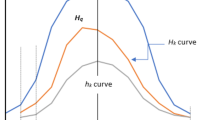Abstract
Marques and Almeida [9] recently proposed a nonlinear data seperation technique based on the maximum entropy principle of Bell and Sejnowsky. The idea behind is a pattern repulsion model alluding to repulsion of physical particles in a restricted system which leads to a uniform distribution, hence a maximum entropy, under certain conditions to the energy function. In this paper, we want to revisite their model and give a rigorous mathematical framework in which this algorithm indeed converges to a demixing function.
Access this chapter
Tax calculation will be finalised at checkout
Purchases are for personal use only
Preview
Unable to display preview. Download preview PDF.
Similar content being viewed by others
References
L.B. Almeida, Multilayered Perceptrons. Handbook of Neural Computation by E. Fiesler and R. Beale, Eds. Institute of Physics (1997), Oxford University Press, available at http://www.oupusa.org/acadref/ncc1_2.pdf
M. Anthony-P.L. Barlett, Neural Network Learning: Theoretical Foundations. Cambridge University Press.
H. Bauer, Maš-und Integrationstheorie. Walter de Gruyter, Berlin-New York (1990).
H. Bauer, Wahrscheinlichkeitstheorie. 4. Auage, Walter de Gruyter, Berlin-New York (1990).
P. Comon, Independent component analysis-a new concept? Signal Processing, (36), pp. 287–314 (1994).
S. Haykin, Neural Networks. Macmillan College Publishing Company (1994).
K. Hornik-M. Stinchcombe-H. White, Multilayer feedforward networks are universal approximators. Neural Networks, (2), pp. 359–366 (1989).
A. Hyvärinen-P. Pajunen, Nonlinear Independent Component Analysis: Existence and Uniqueness Results. Preprint.
G.C. Marques-L.B. Almeida, Separation of nonlinear mixtures using pattern repulsion. in J.F. Cardoso, Ch. Jutten, Th. Loubaton EDS. ICA’ 99, pp. 277–283.
F.J. Theis, Ch. Bauer, E. Lang, Comparison of ME and MMI in a nonlinear setting preprint (2001).
F. Topsøe, FrInformationstheorie. Teubner Studienbücher Mathematik (1973).
Author information
Authors and Affiliations
Editor information
Editors and Affiliations
Rights and permissions
Copyright information
© 2001 Springer-Verlag Berlin Heidelberg
About this paper
Cite this paper
Theis, F.J., Bauer, C., Puntonet, C., Lang, E.W. (2001). Pattern Repulsion Revisited. In: Mira, J., Prieto, A. (eds) Bio-Inspired Applications of Connectionism. IWANN 2001. Lecture Notes in Computer Science, vol 2085. Springer, Berlin, Heidelberg. https://doi.org/10.1007/3-540-45723-2_94
Download citation
DOI: https://doi.org/10.1007/3-540-45723-2_94
Published:
Publisher Name: Springer, Berlin, Heidelberg
Print ISBN: 978-3-540-42237-2
Online ISBN: 978-3-540-45723-7
eBook Packages: Springer Book Archive




